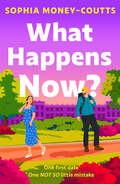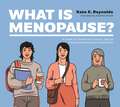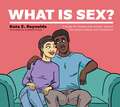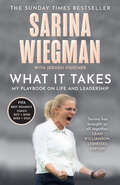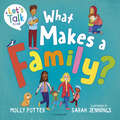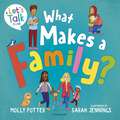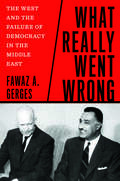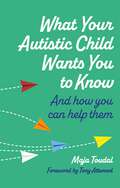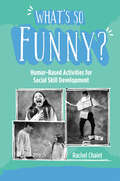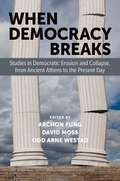- Table View
- List View
What Happens Now?
by null Sophia Money-Coutts‘Will have you in fits of laughter… move over, Bridget Jones!’ New ‘Surprisingly funny and very saucy’ OK! ‘A laugh-a-minute page-turner, perfect for poolside reading!’ HELLO! ‘Surprisingly saucy and distractingly funny’ GRAZIA ‘No question about it, there are two little purple lines. I’m pregnant.’ After eight years together, Lil Bailey thought she’d already found ‘the one’ – that is, until he dumped her for a blonde twenty-something colleague. So she does what any self-respecting singleton would do: swipes right, puts on her best bra and finds herself on a first date with a handsome mountaineer called Max. What’s the worst that can happen? Well it’s pretty bad actually. First Max ghosts her and then, after weeing on a stick (but mostly her hands), a few weeks later Lil discovers she’s pregnant. She’s single, thirty-one and living in a thimble-sized flat in London, it’s hardly the happily-ever-after she was looking for. Lil’s ready to do the baby-thing on her own – it can’t be that hard, right? But she should probably tell Max, if she can track him down. Surely he’s not that Max, the highly eligible, headline-grabbing son of Lord and Lady Rushbrooke, currently trekking up a mountain in South Asia? Oh, maybe he wasn’t ignoring Lil after all… Praise for Sophia Money-Coutts: ‘So funny. And the sex is amazing!’ Jilly Cooper ‘Hilariously funny – I couldn’t put it down.’ Beth O’Leary ‘A laugh-a-minute page-turner, perfect for poolside reading!’ HELLO! ‘This hilarious novel proves Sophia Money-Coutts is mistress of the romp-com.’ The Sun ‘Howlingly funny’ Sunday Times ‘Wonderfully rude’ Red ‘Surprisingly saucy and distractingly funny’ Grazia ‘Funny and beautifully written … I loved it’ Daily Mail ‘Fizzes with joy’ Metro ‘Hilarious and uplifting’ Woman & Home ‘A thoroughly modern love story’ Woman’s Weekly ‘Does it earn its place in your beach bag? Absolutely’ Evening Standard
What Ho! P. G. Wodehouse on Hollywood (What Ho! P. G. Wodehouse)
by Paul Kent"It isn't half such a crazy place as it's made out to be. I know two- three people in Hollywood that are part sane." A talking gorilla called Cyril who graduated from Oxford University; a sword-wielding diva driven crazy by her orange juice diet; an English milord swapping bodies with a gobby 12 year-old film star – these are screwball plots even by P. G. 'Plum' Wodehouse's brilliant comic standards. But not so surprising when we learn they take place in "the weirdest place" he had ever worked – Hollywood. Paul Kent's eighth essay on matters Wodehousean is a backstage pass to "Dottyville-on-the-Pacific's" Golden Age in the 1930's, replete with glamour, glitter and the monstrous egos of its biggest movers and shakers. You'll be SHOCKED! You'll be THRILLED! – but above all, you'll be ENTERTAINED!
What Ho! P. G. Wodehouse on Money (What Ho! P. G. Wodehouse)
by Paul Kent"[I'm] as broke as the ten commandments." P. G. "Plum" Wodehouse knew a thing or two about the money-go-round; in 1938 he was the world's highest paid writer. At times, his financial affairs read like one of his own comic plots, as British and American tax inspectors chased him from pillar to post across two continents. Many of his characters are similarly afflicted: but whether they have too much or too little splosh in the old sock, they always seem to learn – in the funniest ways possible – that money is an excellent servant and a terrible master. The fifth of Paul Kent's occasional essays on matters Wodehousean is packed with paupers and plutocrats, meritocrats and misers all mooching with Mammon. It most certainly is funny in this rich man's world!
What I Say: Conversations That Improve the Physician-Patient Relationship
by Jack Parker Robert OsherPhysicians of all disciplines know (or quickly learn the hard way) that effective and compassionate communication is arguably the single most important determinant of patient satisfaction. For cataract surgeons, the words said before, after, and even during the operation are often more important to the patient’s happiness than the objective quality of the surgical result.What I Say: Conversations that Improve the Physician-Patient Relationship is designed to help cataract surgeons to hone their verbal interactions to be as sharp as their surgical skills. Muddled, clumsy, or impromptu explanations diminish the doctor-patient relationship and could prevent patients from receiving the surgery they need or appreciating the results they get. Knowing in advance which words to use in difficult situations is analogous to knowing how to manage a complication before it occurs. The results are inevitably better when a physician has considered every possible outcome instead of attempting to come up with exactly the right solution on the spot. Rather than figure out the right words by trial and error, however, What I Say has recommendations on exactly what to say to build strong and trusting patient relationships. Drs. Robert Osher and Jack Parker have compiled conversational scripts from Dr. Osher’s 40-year career in ophthalmology, as well as contributions from over a dozen international mavens of bedside manner into a strategy guide through even the most difficult patient conversations that inevitably surround cataract surgery.Topics include: Lowering Expectations for Spectacle-Free Vision The Torn Posterior Capsule Postoperative Refractive Surprise The Dropped Nucleus The Unhappy Patient Despite a Good Result Containing examples of conversations with cataract surgery patients where informing and reassuring take top priority, What I Say: Conversations that Improve the Physician-Patient Relationship was created to aid cataract surgeons in their pre-operative, intra-operative, and post-operative interactions with patients. With the advice contained inside, surgeons will be able to motivate patients, calibrate expectations, and diffuse frustrations in every possible scenario.
What I Say: Conversations That Improve the Physician-Patient Relationship
by Jack Parker Robert OsherPhysicians of all disciplines know (or quickly learn the hard way) that effective and compassionate communication is arguably the single most important determinant of patient satisfaction. For cataract surgeons, the words said before, after, and even during the operation are often more important to the patient’s happiness than the objective quality of the surgical result.What I Say: Conversations that Improve the Physician-Patient Relationship is designed to help cataract surgeons to hone their verbal interactions to be as sharp as their surgical skills. Muddled, clumsy, or impromptu explanations diminish the doctor-patient relationship and could prevent patients from receiving the surgery they need or appreciating the results they get. Knowing in advance which words to use in difficult situations is analogous to knowing how to manage a complication before it occurs. The results are inevitably better when a physician has considered every possible outcome instead of attempting to come up with exactly the right solution on the spot. Rather than figure out the right words by trial and error, however, What I Say has recommendations on exactly what to say to build strong and trusting patient relationships. Drs. Robert Osher and Jack Parker have compiled conversational scripts from Dr. Osher’s 40-year career in ophthalmology, as well as contributions from over a dozen international mavens of bedside manner into a strategy guide through even the most difficult patient conversations that inevitably surround cataract surgery.Topics include: Lowering Expectations for Spectacle-Free Vision The Torn Posterior Capsule Postoperative Refractive Surprise The Dropped Nucleus The Unhappy Patient Despite a Good Result Containing examples of conversations with cataract surgery patients where informing and reassuring take top priority, What I Say: Conversations that Improve the Physician-Patient Relationship was created to aid cataract surgeons in their pre-operative, intra-operative, and post-operative interactions with patients. With the advice contained inside, surgeons will be able to motivate patients, calibrate expectations, and diffuse frustrations in every possible scenario.
What I Want to Talk About: How Autistic Special Interests Shape a Life
by Pete Wharmby'This book isn't a memoir. It is a love letter to the phenomenon of autistic hyperfixation.'In What I Want to Talk About popular autism advocate Pete Wharmby takes readers on a journey through his special interests, illuminating the challenges of autistic experience along the way. Funny, revealing, celebratory and powerful in equal measure, this is a book that will resonate with many, and which should be required reading for anyone who wants to understand autism with more accuracy and empathy.
What is Health?
by Ruth CrossWhat is health? What does health mean to people? How do we make sense of health and experience it? There are no simple answers to these questions. Health is complex, subjective and varied. Drawing on theory, research and contemporary debates, Ruth Cross explores the nature of health in depth and challenges our thinking about it. Moving beyond taken-for-granted assumptions, she gives the meaning of ‘health’ its due attention, exploring everyday perspectives as well as ‘expert’ medical, academic and policy understandings and approaches. In doing so, the book brings together different knowledge and expertise on health, also considering the inextricable links between human and planetary health. This book is important for all those working in the health field, or training to do so, seeking a broad understanding about health and all its complexity.
What Is Menopause?: A Guide for People with Autism, Special Educational Needs and Disabilities
by Kate E. ReynoldsThis carefully written and explicitly illustrated book provides an explanation of menopause for people with autism and special education needs and disabilities (SEND). It helps readers to understand the physical processes and symptoms of menopause, as well as important practical information, such as how to cope with the emotional and hormonal changes in menopause, complementary therapies and tips on how to effectively communicate your experiences to support networks and professionals such as, doctors and therapists.Menopause is rarely recognised or addressed with people who have autism, special educational needs and disabilities (SEND) yet it has a significant impact on their daily living. This book frankly explains what constitutes menopause, that it is part of the life course and can be actively managed. As part of the 'Healthy Loving, Healthy Living' series, this book is written in gender neutral and inclusive language.
What Is Sex?: A Guide for People with Autism, Special Educational Needs and Disabilities (Healthy Loving, Healthy Living)
by Kate E. ReynoldsThis carefully written and illustrated book provides an explanation of sex for people with autism and special education needs and disabilities (SEND). It helps readers to understand the physical processes as well as important issues such as consent and sexual safety, helping them to develop positive relationships.Many people with autism and SEND have or will have intimate relationships. Often sex is alluded to, rather than being carefully explored. This can create confusion around consent, sexual health, and pregnancy, and cause people to turn to dubious online information. This book frankly explains sex so that the reader has a clear understanding of what constitutes sex, knowledge of the proper names for sexual organs and sexual activities, and is aware of the potential physical consequences of having sex.
What It Takes: My Playbook on Life and Leadership
by null Sarina WiegmanWinning strategies of one of football’s most successful coaches As FIFA's most decorated female football manager and a former player, Sarina Wiegman has led both the Netherlands and England women's national teams to historic victories. She stands out as a true pioneer in the game, and her coaching philosophy has earned her a reputation as one of the most successful coaches in football history. This personal account of Sarina's life journey begins with her early passion for football, and covers her key moments on the pitch as well as her ascension to the top of the coaching world. Join Sarina as she talks us through her rollercoaster ride of victories and challenges, the tough decisions she had to make both on and off the pitch, and the relentless pursuit of excellence that saw her rise to become an indomitable figure in the world of sports. And, it’s not just about the game. In a world where football has become more competitive than ever, Sarina's revolutionary approach to leadership, mentorship, and performance management has garnered global attention. In What It Takes we gain invaluable insight into Sarina’s unique philosophy, as she shares how she fostered an environment that values determination, teamwork, and mutual respect. A strong advocate for women in the sport, she outlines a transformative and inclusive future for football where everyone has an equal chance to shine, irrespective of gender.
What Makes a Family?: A Let’s Talk picture book to help young children understand different types of families (Let's Talk)
by Molly PotterFrom the bestselling author of How Are You Feeling Today?, this picture book helps children understand and celebrate different types of families.What Makes a Family? explores different types of families, from what makes them unique to what they all have in common. Using everyday examples, clear explanations and colourful illustrations by Sarah Jennings, this book encourages children to celebrate families of all shapes and sizes. This diverse picture book covers lots of different family structures, including nuclear families, blended families, LGBTQ+ families, single-parent families, fostering and adoption. It's the perfect resource for starting important conversations with children about what different families can look like, and the love that holds them all together.Let's Talk books help you start meaningful conversations with your child. Written by an expert and covering topics like feelings, relationships, diversity and mental health, these comforting picture books support healthy discussion right from the start.
What Makes a Family?: A Let’s Talk picture book to help young children understand different types of families (Let's Talk)
by Molly PotterFrom the bestselling author of How Are You Feeling Today?, this picture book helps children understand and celebrate different types of families.What Makes a Family? explores different types of families, from what makes them unique to what they all have in common. Using everyday examples, clear explanations and colourful illustrations by Sarah Jennings, this book encourages children to celebrate families of all shapes and sizes. This diverse picture book covers lots of different family structures, including nuclear families, blended families, LGBTQ+ families, single-parent families, fostering and adoption. It's the perfect resource for starting important conversations with children about what different families can look like, and the love that holds them all together.Let's Talk books help you start meaningful conversations with your child. Written by an expert and covering topics like feelings, relationships, diversity and mental health, these comforting picture books support healthy discussion right from the start.
What Really Went Wrong: The West and the Failure of Democracy in the Middle East
by Fawaz A. GergesAn ambitious revisionist history of the modern Middle East What Really Went Wrong offers a fresh and incisive assessment of American foreign policy’s impact on the history and politics of the modern Middle East. Looking at flashpoints in Iranian, Egyptian, Syrian, and Lebanese history, Fawaz A. Gerges shows how postwar U.S. leaders made a devil’s pact with potentates, autocrats, and strongmen around the world. Washington sought to tame assertive nationalists and to protect repressive Middle Eastern regimes in return for compliance with American hegemonic designs and uninterrupted flows of cheap oil. The book takes a counterfactual approach, asking readers to consider how the political trajectories of these countries and, by extension, the entire region may have differed had U.S. foreign policy privileged the nationalist aspirations of patriotic and independent Middle Eastern leaders and people. Gerges argues that rather than focusing on rolling back communism, extracting oil, and pursuing interventionist and imperial policies in Iran, Egypt, and beyond, postwar U.S. leaders should have allowed the Middle East greater autonomy in charting its own political and economic development. In so doing, the contemporary Middle East may have had better prospects for stability, prosperity, peace, and democracy.
What Went Wrong With Capitalism
by Ruchir SharmaA radical examination by a leading financial analyst, commentator and investor of the ills of capitalism and how they can be fixedWhat went wrong with capitalism? Ruchir Sharma’s explanation is unlike any you have heard before. Progressives are partly right when they mock modern capitalism as “socialism for the rich,” but what really happened in recent decades is that government in developed nations expanded in just about every measurable dimension, from spending and regulation to the sheer scale of its rescues each time the economy wobbled. The result, Sharma says, is “socialized risk,” expensive government guarantees, for everyone—welfare for the poor, entitlements for the middle class, and bailouts for the rich.Voters say they are disillusioned with capitalism, but a system so distorted by government interventions is a dysfunctional version of free market ideals. As a result, productivity and economic growth have slowed sharply, shrinking the pie for everyone and stoking popular anger. Since these flaws developed as the government expanded, building an even bigger state will only double down on what’s gone wrong. The answer Sharma offers is a series of seven fixes to restore the balance between state support and free markets and lay the path to a more prosperous and happier future.
What Work Means: Beyond the Puritan Work Ethic
by Claudia StraussWhat Work Means goes beyond the stereotypes and captures the diverse ways Americans view work as a part of a good life. Dispelling the notion of Americans as mere workaholics, Claudia Strauss presents a more nuanced perspective. While some live to work, others prefer a diligent 9-to-5 work ethic that is conscientious but preserves time for other interests. Her participants often enjoyed their jobs without making work the focus of their life. These findings challenge laborist views of waged work as central to a good life as well as post-work theories that treat work solely as exploitative and soul-crushing. Drawing upon the evocative stories of unemployed Americans from a wide range of occupations, from day laborers to corporate managers, both immigrant and native-born, Strauss explores how diverse Americans think about the place of work in a good life, gendered meanings of breadwinning, accepting financial support from family, friends, and the state, and what the ever-elusive American dream means to them. By considering how post-Fordist unemployment experiences diverge from joblessness earlier, What Work Means paves the way for a historically and culturally informed discussion of work meanings in a future of teleworking, greater automation, and increasing nonstandard employment.
What You Are Looking for is in the Library: The uplifting Japanese fiction bestseller
by Michiko AoyamaTHE TWO-MILLION-COPY BESTSELLING JAPANESE NOVELThe Top Ten Times bestsellerA Time Magazine Book of the Year'An undeniable page-turner' New York Times'I ADORED this uplifting, hopeful novel ' Daily Mail'It made me laugh and cry and feel comforted' 5***** Reader review'A tribute to the transformative power of books and libraries' Irish TimesAn inspirational tale of the love, comfort and growth you can find in the pages of a good book._________________What are you looking for?So asks Tokyo's most enigmatic librarian, Sayuri Komachi.But she is no ordinary librarian.Sensing exactly what someone is searching for in life, she provides just the book recommendation to help them find it.We meet five visitors to the library, each at a different crossroads:- The restless retail assistant eager to pick up new skills- The mother faced with a demotion at work after maternity leave- The conscientious accountant who yearns to open an antique store- The gifted young manga artist in search of motivation- The recently retired salaryman on a quest for newfound purposeCan she help them find what they are looking for?Which book will you recommend?_________________'An undeniable page-turner' New York TimesFor fans of The Midnight Library and Before the Coffee Gets Cold, this feel-good Japanese book shows how the perfect book recommendation can change a life.SHORTLISTED FOR THE JAPAN BOOKSELLERS' AWARD'I definitely want to visit this library. I feel kinder after this book' 5***** Reader review'A quirky slice of feel-good fiction that you could recommend to anyone' Mail on Sunday'Wonderful. It made me look for connection in my life' 5***** Reader reviewTimes bestseller, August 2023
What You Really Want to Know About Life with Dementia: Real stories and expert advice for family, friends and people with dementia
by Karen Harrison Dening Hilda Hayo Christine ReddallSelected for Reading Well for Dementia 2024: endorsed by health experts, charities and people affected by dementia.A family-led vision of what carers of people with dementia need and want to know. Supporting families and carers in their day-to-day life with dementia, this unique resource combines real stories from families with expert responses and advice for specific issues and concerns.This resource is based on the real stories and real questions brought to the Admiral Nurse Dementia Helpline, peer support groups and clinical networks. Including questions around diagnosis, peer support, balancing risks, care transitions and end of life planning, the chapters are devised to support you, and give you the tools to live better, when dementia enters your life.
What Your ADHD Child Wishes You Knew
by Sharon SalineA veteran psychologist presents a proven roadmap to help ADHD kids succeed in school and life
What Your Autistic Child Wants You to Know: And How You Can Help Them
by Maja Toudal"There are so many things I wish I could have told my parents when I was a child, but back then I did not have the words."It can be challenging understanding what your autistic child wants and needs, at times it can feel like a struggle to ask the right questions and find the right words.Written by autistic psychologist and advocate, Maja Toudal, in collaboration with other autistic voices, this candid book explores a range of common situational and social challenges an autistic young person may face and gives lived-experience advice on how to resolve them. Maja offers insights on everything from making mealtimes work for your child, to handling bullying and peer pressure, both at school and on social media, providing an insider's guide into the child's emotional life.With relatable and engaging advice on what your child needs and why, alongside chapters focusing on how to approach puberty, providing coping mechanisms for meltdowns, and offering insight into making safe spaces, this is the essential guide to parenting autistic young people.
What's Murder Between Friends
by Meg Gatland-Veness'I think it was one of us,' Walter says … 'We had the perfect opportunity. Everyone's thinking it, I'm just saying it.' The last thing Hallie and her drama classmates expect to find on a high school scavenger hunt is a dead body. In a town with a population of about thirty-six, no one has experience with murder investigations, but now everyone's asking: who killed Ms Lovelace. The drama kids thought they were the only people nerdy enough to be at school on a Sunday. When they learn that Adam Tolentino, football star, drama-club nemesis and the hottest boy in school, was there too, Hallie is given the task of finding out what he knows – but she soon learns there's more to Adam than meets the eye. Although still grieving her favourite teacher, Hallie knows the show must go on. Managing a musical and a murder investigation is a lot, but Hallie and her friends won't give up on Ms Lovelace – or each other.
What's So Funny?: Humor-Based Activities for Social Skill Development
by Rachel ChaietWith ready-to-use lessons and strategies, What’s So Funny?: Humor-Based Activities for Social Skill Development provides readers with tools to help their clients improve their emotional intelligence through humor. Occupational therapists, speech-language pathologists, special educators, behavior therapists, and caregivers will benefit from the implementation of these strategies.What’s So Funny? contains a curriculum of more than 50 activities that emphasize two main ideas. The first is that humor (linguistic or physical) can be taught to many individuals with autism spectrum disorder or other disorders through explicit instruction, exposure to various types of humor, and embracing the individual’s preferred sense of humor. The second is that humorous activities can be used to increase social engagement, which can sometimes be a challenge for those with developmental disabilities.What’s So Funny? includes activities essential for individuals who: Appear to have a very limited concept or basic developmental level of humor Need to improve their understanding of socially appropriate humor Lack understanding of appropriate times to use humor Are nonverbal, have limited expressive communication skills, or use augmentative communication devices Have a difficult time initiating social interactions with their peers With a flexible program that can be used for either small groups or individuals from ages 7 years to adult, What’s So Funny?: Humor-Based Activities for Social Skill Development is a relevant and easy-to-use resource. Discussing a variety of types of humor on different developmental levels, from slapstick to word play, this program improves participants’ abilities to connect and engage with others through the powerful tool of humor.
What's So Funny?: Humor-Based Activities for Social Skill Development
by Rachel ChaietWith ready-to-use lessons and strategies, What’s So Funny?: Humor-Based Activities for Social Skill Development provides readers with tools to help their clients improve their emotional intelligence through humor. Occupational therapists, speech-language pathologists, special educators, behavior therapists, and caregivers will benefit from the implementation of these strategies.What’s So Funny? contains a curriculum of more than 50 activities that emphasize two main ideas. The first is that humor (linguistic or physical) can be taught to many individuals with autism spectrum disorder or other disorders through explicit instruction, exposure to various types of humor, and embracing the individual’s preferred sense of humor. The second is that humorous activities can be used to increase social engagement, which can sometimes be a challenge for those with developmental disabilities.What’s So Funny? includes activities essential for individuals who: Appear to have a very limited concept or basic developmental level of humor Need to improve their understanding of socially appropriate humor Lack understanding of appropriate times to use humor Are nonverbal, have limited expressive communication skills, or use augmentative communication devices Have a difficult time initiating social interactions with their peers With a flexible program that can be used for either small groups or individuals from ages 7 years to adult, What’s So Funny?: Humor-Based Activities for Social Skill Development is a relevant and easy-to-use resource. Discussing a variety of types of humor on different developmental levels, from slapstick to word play, this program improves participants’ abilities to connect and engage with others through the powerful tool of humor.
When Democracy Breaks: Studies in Democratic Erosion and Collapse, from Ancient Athens to the Present Day
by Archon Fung, David Moss and Odd Arne WestadThis is an open access title available under the terms of a CC BY-NC-ND 4.0 International licence. It is free to read on the Oxford Academic platform and offered as a free PDF download from OUP and selected open access locations. Democracy is often described in two opposite ways, as either wonderfully resilient or dangerously fragile. Both characterizations can be correct, depending on the context. When Democracy Breaks aims to deepen our understanding of what separates democratic resilience from democratic fragility by focusing on the latter. The volume's collaborators--experts in the history and politics of the societies covered in their chapters--explore eleven episodes of democratic breakdown, from ancient Athens to Weimar Germany to present-day Russia, Turkey, and Venezuela. Strikingly, in every case, various forms of democratic erosion long preceded the final democratic breakdown. Although no single causal factor emerges as decisive, linking together all of the episodes, some important commonalities--including extreme political polarization, explicitly anti-democratic political actors, and significant political violence--stand out across the cases. Moreover, the notion of democratic culture, while admittedly difficult to define and even more difficult to measure, may play a role in all of them. Throughout the volume, the contributors show again and again that the written rules of democracy are insufficient to protect against tyranny. While each case of democratic decay is unique, the patterns that emerge shed much light on the continuing struggle to sustain modern democracies and to assess and respond to the threats they face.
When Democracy Breaks: Studies in Democratic Erosion and Collapse, from Ancient Athens to the Present Day
This is an open access title available under the terms of a CC BY-NC-ND 4.0 International licence. It is free to read on the Oxford Academic platform and offered as a free PDF download from OUP and selected open access locations. Democracy is often described in two opposite ways, as either wonderfully resilient or dangerously fragile. Both characterizations can be correct, depending on the context. When Democracy Breaks aims to deepen our understanding of what separates democratic resilience from democratic fragility by focusing on the latter. The volume's collaborators--experts in the history and politics of the societies covered in their chapters--explore eleven episodes of democratic breakdown, from ancient Athens to Weimar Germany to present-day Russia, Turkey, and Venezuela. Strikingly, in every case, various forms of democratic erosion long preceded the final democratic breakdown. Although no single causal factor emerges as decisive, linking together all of the episodes, some important commonalities--including extreme political polarization, explicitly anti-democratic political actors, and significant political violence--stand out across the cases. Moreover, the notion of democratic culture, while admittedly difficult to define and even more difficult to measure, may play a role in all of them. Throughout the volume, the contributors show again and again that the written rules of democracy are insufficient to protect against tyranny. While each case of democratic decay is unique, the patterns that emerge shed much light on the continuing struggle to sustain modern democracies and to assess and respond to the threats they face.
